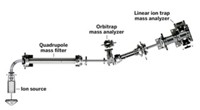Advertisement
Grab your lab coat. Let's get started
Welcome!
Welcome!
Create an account below to get 6 C&EN articles per month, receive newsletters and more - all free.
It seems this is your first time logging in online. Please enter the following information to continue.
As an ACS member you automatically get access to this site. All we need is few more details to create your reading experience.
Not you? Sign in with a different account.
Not you? Sign in with a different account.
ERROR 1
ERROR 1
ERROR 2
ERROR 2
ERROR 2
ERROR 2
ERROR 2
Password and Confirm password must match.
If you have an ACS member number, please enter it here so we can link this account to your membership. (optional)
ERROR 2
ACS values your privacy. By submitting your information, you are gaining access to C&EN and subscribing to our weekly newsletter. We use the information you provide to make your reading experience better, and we will never sell your data to third party members.
Analytical Chemistry
Inside Instrumentation
Technology and Business news for the laboratory world
by Celia H. Arnaud and Ann M. Thayer
June 1, 2009
| A version of this story appeared in
Volume 87, Issue 22
(1) Dolomite Offers Micromixer Chip
The Dolomite Center, a U.K.-based microfluidics device developer, has introduced the Mitos Micromixer, a glass chip designed for rapidly mixing two or three fluid streams at different flow rates. The 45- x 15-mm chip has two independent channels, each with a volume of 8 µL, in which mixing occurs within milliseconds. In addition to operating at a range of temperatures and pressures, the chip is compatible with a variety of chemicals and can be used to study reaction kinetics, sample dilution, crystallization, and nanoparticle synthesis.
PerkinElmer Buys Analytica
PerkinElmer has acquired Analytica of Branford Inc., a developer of mass spectrometry and ion-source technology. Located in Branford, Conn., Analytica was founded in 1987 by Craig Whitehouse, who developed one of the first electrospray ion sources while at Yale University. PerkinElmer will integrate Analytica's manufacturing operations into its Shelton, Conn., facility and continue to use Analytica's existing Branford site for R&D projects. Whitehouse will join PerkinElmer and oversee its MS R&D operations.
Agilent Introduces LC, CE Systems
Agilent has unveiled the 1290 Infinity Liquid Chromatography System and the 7100 Capillary Electrophoresis System. The 1290 Infinity allows users to employ columns of any size, any particle type, and any mobile or stationary phase. Such flexibility should make it easier to transfer methods between systems. It also features a new pump and a new UV diode array detector. The 7100—which is aimed at the biotechnology, environmental, food safety, and life sciences markets—has a 25% smaller footprint, weighs 30% less, and uses less power than its predecessor. Both the 1290 Infinity and the 7100 are compatible with Agilent's full line of mass spectrometers.
(2) Multidimensional GC System From Shimadzu
Shimadzu's new Multi-Dimensional Gas Chromatography (MDGC) system (shown below) improves separations by combining two capillary columns with different selectivities. The MDGC system incorporates a capillary-optimized pressure-switching device that directs flow from the first column to a detector or to a second column. The device uses an electronic flow controller to balance the pressure on both sides of the transfer line between columns. The system is available in both dual- and single-oven designs.
(3) New Mass Specs Make Their Debut
Thermo Fisher Scientific and Bruker Daltonics have announced next-generation mass spectrometers. Thermo Fisher launched the LTQ Velos and the LTQ Orbitrap Velos at ACHEMA 2009, in Frankfurt, Germany, last month. The LTQ Velos linear ion-trap mass spectrometer features a dual-pressure trap design that allows the decoupling of ion manipulation and detection, resulting in faster scan speeds and improved resolution. The LTQ Orbitrap Velos (shown) incorporates a new, higher energy collisional dissociation cell. Meanwhile, Bruker has introduced the amaZon ion-trap mass spectrometer and the solariX hybrid quadrupole Fourier transform mass spectrometer. Both systems have dual-ion-funnel technology, which improves ion transfer and thus sensitivity. The amaZon series includes two versions, the amaZon ETD for proteomics applications and the amaZon X for small-molecule analysis. The solariX has improved mass-resolving power, sensitivity, and dynamic range relative to its predecessors. It is geared to complex mixture analysis in applications such as "top down" (whole protein) proteomics, petroleomics, and metabolomics.
Sequencing Systems Enable Advances
Two companies have announced advances made possible by their DNA-sequencing technology. Using samples obtained from the Baylor College of Medicine Human Genome Sequencing Center, scientists at Applied Biosystems, a division of Life Technologies, used the SOLiD 3 System to sequence an entire human genome in a single run at 17-fold coverage. Separately, a collaboration among Sime Darby, a Malaysian conglomerate; Synamatix, a Malaysian bioinformatics company; and 454 Life Sciences revealed that it has used 454's technology to sequence the 1.7 billion-base-pair oil palm genome. Palm oil is used in food, health supplements, and cosmetics. It is also used as a biofuel. The plant's genome was sequenced without conventional Sanger sequencing data.
Celia H. Arnaud and Ann M. Thayer write Inside Instrumentation. Contact them via e-mail to instrumentation@acs.org.
.






Join the conversation
Contact the reporter
Submit a Letter to the Editor for publication
Engage with us on Twitter